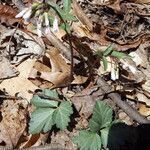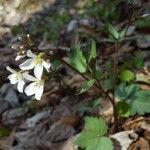Perennials; usually glabrous, rarely sparsely pubescent. Rhizomes (tuberiform, fragile) moniliform, segments fusiform, 3-6 mm diam. (fleshy). Stems erect, unbranched, 1.2-3(-4) dm, glabrous or pubescent. Rhizomal leaves 3-foliolate, to 24 cm, leaflets petiolulate or subsessile; petiole (3-) 5-12(-16) cm; lateral leaflets subsessile or petiolulate (0.2-1 cm), blade similar to terminal leaflet or smaller; terminal leaflet (petiolule (0.2-)0.5-1.5(-2) cm, blade broadly ovate to rhombic-obovate, 1.5-6(-8) cm, base usually cuneate, rarely subtruncate, margins coarsely dentate to crenate or 3-lobed, surfaces puberulent or not. Cauline leaves 2 (or 3), 3-foliolate (usually alternate, rarely opposite, different in morphology from rhizomal), petiolate, leaflets petiolulate or sessile; petiole 0.5-2 cm, base not auriculate; lateral leaflets sessile, blade similar to terminal, smaller, margins usually dentate, rarely entire; terminal leaflet sessile or petiolulate, blade narrowly lanceolate to narrowly oblong or oblong-lanceolate, 2-7 × 0.3-0.6 cm, margins minutely puberulent. Racemes ebracteate. Fruiting pedicels ascending to divaricate, 15-40 mm. Flowers: sepals oblong, 5-7.5 × 1-2 mm, lateral pair slightly saccate basally; petals purple to pale pink, oblanceolate, 9-18 × 2-5 mm (clawed, apex rounded); filaments: median pairs 5-10 mm, lateral pair 3.5-8 mm; anthers linear, 1.5-3 mm. Fruits linear, 2.5-4 cm × 1.5-2.5 mm; ovules 8-12 per ovary; style (5-)7-11 mm. Seeds dark brown, oblong, 2-2.5 × 1-1.5 mm. 2n = ca. 128.
More
Rhizome constricted at intervals, stems 2–4 dm, glabrous or rarely a little hairy; basal lvs like those of no. 1 [Cardamine diphylla (Michx.) A. W. Wood], with broad, coarsely crenate-toothed segments; cauline lvs 2(3), opposite or nearly so, their segments narrowly lanceolate, sharply toothed to entire, as in no. 3 [Cardamine concatenata (Michx.) O. Schwarz]; sep 5–8 mm; pet 10–15 mm, faintly pinkish-lavender; frs 2–4 cm; 2 n=128. Rich woods; N.J. to Ind., s. to Ga. and Miss. Apr., May. (Dentaria heterophylla) A very similar pl from Conn., with the segments of the cauline lvs confluent at base, has been called Dentaria incisifolia Eames.


